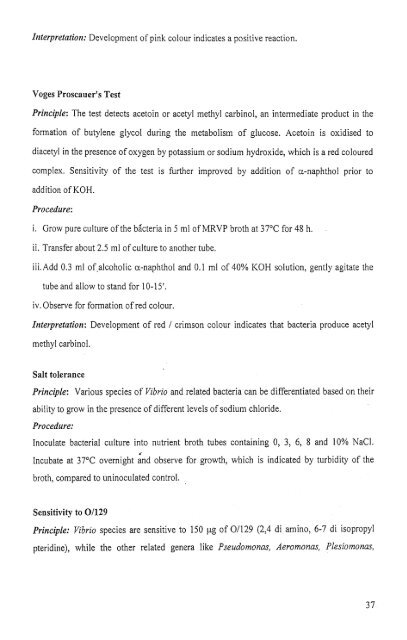, Diagnosis an-&& of Shrimp Diseases - Central Institute of ...
, Diagnosis an-&& of Shrimp Diseases - Central Institute of ...
, Diagnosis an-&& of Shrimp Diseases - Central Institute of ...
- No tags were found...
Create successful ePaper yourself
Turn your PDF publications into a flip-book with our unique Google optimized e-Paper software.
Iizterpretation: Development <strong>of</strong> pink colour indicates a positive reaction.Voges Proscauer? TestPrinciple: The test detects acetoin or acetyl methyl carbinol, <strong>an</strong> intermediate product in theformation <strong>of</strong> butylene glycol during the metabolism <strong>of</strong> glucose. Acetoin is oxidised todiacetyl in the presence <strong>of</strong> oxygen by potassium or sodium hydroxide, which is a red colouredcomplex. Sensitivity <strong>of</strong> the test is further improved by addition <strong>of</strong> a-naphthol prior toaddition <strong>of</strong> KOH.Procedure:i. Grow pure culture <strong>of</strong> the bicteria in 5 ml <strong>of</strong> MRVP broth at 37°C for 48 h.ii. Tr<strong>an</strong>sfer about 2.5 ml <strong>of</strong> culture to <strong>an</strong>other tube.iii.Add 0.3 ml <strong>of</strong>.alcoholic a-naphthol <strong>an</strong>d 0.1 ml <strong>of</strong> 40% KOH solution, gently agitate thetube <strong>an</strong>d allow to st<strong>an</strong>d for 10-15'.iv. Observe for formation <strong>of</strong> red colour.I~zterpretation: Developinent <strong>of</strong> red / crimson colour indicates that bacteria produce acetylmethyl carbinol.Salt toler<strong>an</strong>cePrinciple: Various species <strong>of</strong> Vibrio <strong>an</strong>d related bacteria c<strong>an</strong> be differentiated based on theirability to grow in the presence <strong>of</strong> different levels <strong>of</strong> sodium chloride.Procedure:Inoculate bacterial culture into nutrient broth tubes containing 0, 3, 6, 8 <strong>an</strong>d 10% NaCI..I'Incubate at 37'C overnight <strong>an</strong>d observe for growth, which is indicated by turbidity <strong>of</strong> thebroth, compared to uninoculated control.Sensitivity to 01129Prirzciple: Vibrio species are sensitive to 150 pg <strong>of</strong> 01129 (2,4 di amino, 6-7 di isopropylpteridine), while the other related genera like Pseudomonas, Aeromonas, Plesiomonas,
















